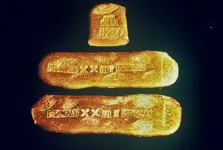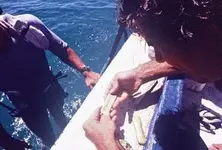Re: Is any of this true?
Emerald Carving an Ancient Art of the Indians of Central and South America (Mesoamerica)
The "Emerald Man" is an artifact in the form of a small stone figurine, representing a male human figure, carved out of a single green emerald crystal, believed to be the oldest known Mesoamerican (middle American) emerald and the only known pre-Columbian carved emerald. The artifact is believed to date back from about 500 B.C. to 250 A. D.
When the Spanish Conquistadors landed in Mexico and Peru, in the 16th century, they found the natives of these lands in possession of large and beautiful emeralds, some of which were cut with great skill into peculiar and characteristic forms. Five stones brought by Cortez to Europe were cut into the shapes of fantastic flowers, fishes and other natural objects. Thus, emerald carving seems to have been an ancient art prevalent in central and southern America since ancient times.
Cortez marches into Tenochtitlan and receives lavish gifts of gold and emeralds which include the Isabella Emerald
The news of the massacres at Cholula reached the Aztec king Montezuma II at Tenochtitlan, who had enough time to plan out a strategy to face the forces of Cortez, if they decided to move towards his capital. Montezuma II was intelligent enough to realize that his forces were not a match to the overwhelming fire power of Cortez's army, and decided not to challenge his army if they chose to enter his capital. On November 8, 1519, Cortez decided to enter Tenochtitlan, and was warmly welcomed by the Aztec emperor Montezuma II, who allowed them to enter the heart of the Aztec empire, without any hindrance. The king then gave lavish gifts of gold, silver and emeralds to Heranan Cortez and his Spanish soldiers, in order to make them happy, and prevent another Cholula-type massacre. Hernan Cortez being the commander was singled out for special treatment, and was showered with large quantities of gold and emeralds by the king. It is believed that the large mystical "Emerald of Judgment" which subsequently came to be known as the "Isabella Emerald" was also among the gifts received by Cortez.
"Isabella Emerald"
According to a letter written by Cortez to king Charles V of Spain around this time, the Aztecs had considered Cortez either as an emissary of the feathered serpent god Quetzalcoatl or Quetzalcoatl himself, which according to an ancient prophecy had predicted that Quetzalcoatl, would return as a white man with a red beard, from the east to reclaim his empire in the year of Reed One. In the year 1519, the year of Reed One, Hernan Cortez, a white man with a red beard, landed from the east, on the shores of the Aztec empire, as if to fulfill that prophecy. This probably explains the behavior of Montezuma II and his people, who initially received Hernan Cortez and his army with great regard and respect, and gifted the "Emerald of Judgment" the most powerful instrument of Aztec culture, to Hernan Cortez, the God Quetzalcoatl reincarnate, to whom the emerald rightfully belonged.
The most significant achievement of this operation was the recovery of the 964-carat, oblong, ancient table-cut, deep green Isabella Emerald, which was the mystical "Emerald of Judgment" presented by Montezuma II to Hernan Cortez on November 8, 1519, and which had been the most valuable possession of the Cortez/Zuinga family up to 1757. The other most significant recovery of the operation was Cortez's signet ring made of silver, with the coat of arms of the Cortes and Zuinga family, used by Cortez as a signature ring to seal and stamp the covers of his official communications with the king of Spain, to maintain their secrecy. Incidentally, the discovery of the signet ring was one of the confirmatory evidences that the shipwreck was indeed that of the ship carrying the Cortez/Zuinga family treasure.
Cortez Silver Signet Ring
Among the other items recovered from the lost treasure include :-
1) Over 100,000 carats of cut and polished emeralds.
2) Over 1,000,000 carats of uncut rough emeralds.
3) The World's largest emerald conglomerate weighing 25,644 carats.
4) 8 very rare Mayan ceremonial crystal skulls.
5) Several Mayan and Aztec jade and gold masks.
6) Hundreds of pieces of gold and emerald jewelry.
7) Several gold and silver bars.
8) Several golden idols.
9) Sacrificial knives and instruments.
10) Other Mayan and Aztec artifacts.
The "Isabella Emerald" had been certified as authentic by a former University of Chicago lapidary professor as well as by the Gemological Institute of America (GIA). The value of the Queen Isabella Emerald has been placed around $20 million.
The dramatic discovery of the mid-18th century shipwreck and the recovery of the lost treasures including the "Isabella Emerald" was given world wide media coverage in all the major newspapers and magazines around the world, The Treasure Diver Magazine and the Sources Magazine, called it the "Greatest Treasure Ever Found" and together with the Time Magazine (International Issue) featured it on their front covers.
Besides being used as an ornamental stone, the emerald was also considered as a sacred stone by the ancient Indian tribes such as the Olmec, Inca, Aztec, Toltec, Maya, Chibcha, Muisca, etc.
Emeralds were offered to their Gods and also buried with their dead. When the Conquistadors tried their best to locate the source of the emeralds in Peru and Mexico and failed, they desecrated the temples and grave yards of the Indian tribes and collected the emerald treasures, which they dispatched to Spain. Jose d'Costa reported that the ship by which he voyaged from Peru to Spain in 1587, carried two cases, each of which contained no less than a hundredweight of emeralds.
Today we know that the failure of the Spanish Conquistadors to discover the source of the emeralds in Peru and Mexico, was simply because there were no emerald mines in Peru and Mexico, and the emeralds used by the natives of these areas were actually brought in from elsewhere. This ancient source of emeralds were situated in the heartland of the Chibcha Indians at Somondoco (Chivor) and the Muzo Indians at Muzo. The emeralds that originated from these mines reached as far south as Bolivia, and as far north as Mexico by trade. The source of the ancient artifacts such as the emerald man which dates back to 500 BC to 250 AD, could also be one of the ancient mines in Colombia, such as the Chivor or Muzo mines.
©Hudson Museum, University of Maine
The Emerald Man
A description of the Emerald Man
The emerald figurine of the man seems to have been carved on a single elongated natural emerald crystal, with the characteristic emerald-green color but with many small areas of blackish-green and yellow mottling. The ancient lapidarists who created the masterpiece had used straight-cuts to fashion the figurine into the shape of a standing man. The man's hands are folded over his mid-section, somewhat similar to the standing posture of a modern-day Muslim devotee in prayer. The man seems to be wearing a short apron and also headgear. Two conical drill holes with a larger diameter in the front than on the reverse side, pass through the figurine under the armpits, and another drill hole passes from side to side through the head. This is obviously to enable the figurine to be suspended on a cord, perhaps to be worn or hung somewhere as an ornament. The dimensions of the figurine are height :- 5.63 cm, width :- 2.85 cm and thickness :- 1.37 cm. The weight of the figurine is 23.7g equivalent to 23.7 x 5 = 118.5 carats.
Hernando Cortes, the conquerer of Mexico, was carrying carved emeralds taken from the Aztecs in the shapes offish and flowers and a carved emerald bell, and an emerald the size of a man's palm when he was ship wrecked. Many of the finest stones were lost forever. The Incas had an emerald goddess, a fabulous emerald the size of an ostrich egg. In tribute they sacrificed her children: smaller emeralds which were presented to the goddess. Treasure hunters seeking wrecks of Spanish galleons are occasionally rewarded with the ultimate treasure: emeralds lost by the conquistadores long ago.
 http://www.divernet.com/other_diving_topics/archaeology/160897/treasurehunting_the_psychic_way.html
http://www.divernet.com/other_diving_topics/archaeology/160897/treasurehunting_the_psychic_way.html http://www.divernet.com/other_diving_topics/archaeology/160897/treasurehunting_the_psychic_way.html
http://www.divernet.com/other_diving_topics/archaeology/160897/treasurehunting_the_psychic_way.html













